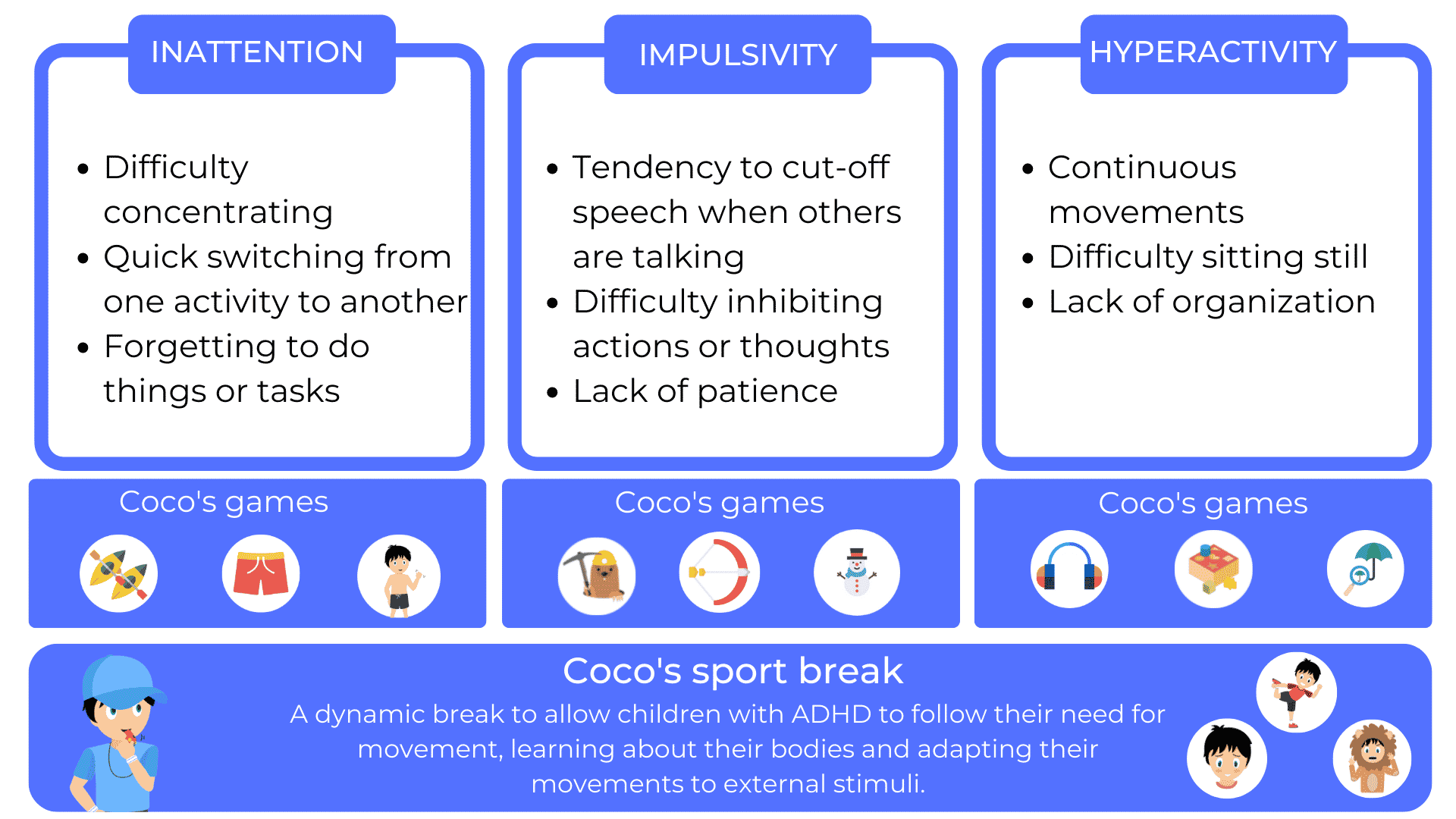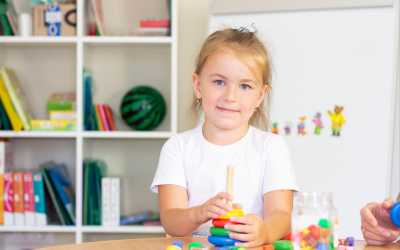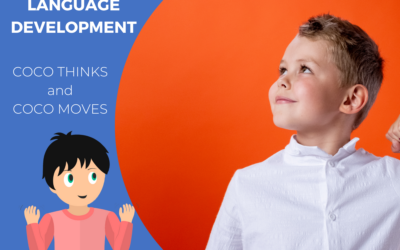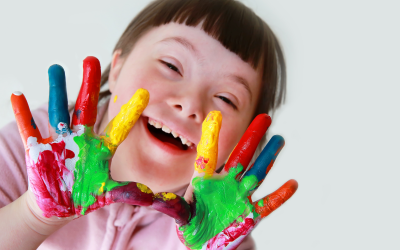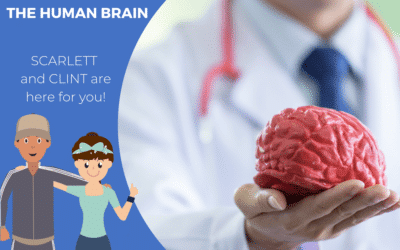Children with Attention Deficit Hyperactivity Disorder (ADHD) can face unique challenges in school. However, with the right support and strategies, they can achieve academic success. In this article, we will share practical tips to help parents support their ADHD children in their school career. We will discuss effective study strategies, classroom accommodations, the importance of building a strong partnership with teachers, and specific tips for time management and communication.
1. Establish a structured study routine
a) Establish regular study schedules
When it comes to supporting the academic success of children with ADHD, establishing regular study schedules is essential. Setting dedicated study times each day allows the child to get used to a rhythm and develop a discipline of study. It is best to choose times when the child is most focused and alert, such as after a period of rest or eating. By identifying the right times to focus, you can maximize productive study time.
b) Creating a supportive learning environment
The environment in which a child studies can have a significant impact on their concentration and productivity. It is recommended to create a quiet, well-organized space away from distractions such as television, video games or electronic devices. Make sure that necessary materials, such as school supplies, books and notebooks, are easily accessible to avoid wasting time and distractions. A well-organized workspace helps create an atmosphere conducive to concentration and learning.

c) Divide tasks into small steps
Children with ADHD can easily feel overwhelmed by large tasks or homework. To help them manage their workload, it is helpful to guide them to break down assignments or projects into smaller, more manageable steps. This allows them to focus on one part at a time, making tasks more achievable and less stressful. Encourage them to make a list of the steps needed to complete a task, and then check off each step as they go along. This gives them a sense of progressive accomplishment and motivates them to continue.
d) Use time management techniques
Time management is critical for children with ADHD. By teaching them time management techniques, you help them better organize their school obligations and avoid procrastination. Encourage them to prioritize by identifying the most important tasks and to set realistic deadlines for each task. Use tools such as calendars, agendas or time management apps to help them plan their activities and meet deadlines. You can also use visual reminders, such as clocks or timers, to help them manage their time effectively.
2. Use multi-sensory learning techniques
a) Use visual aids
Visual aids are effective in helping children with ADHD better understand and organize information. Encourage the use of diagrams, charts, tables, and visuals to represent key concepts or ideas. For example, when learning math, use diagrams or visual models to explain problems and solutions. Visual aids help reinforce understanding and facilitate memorization.
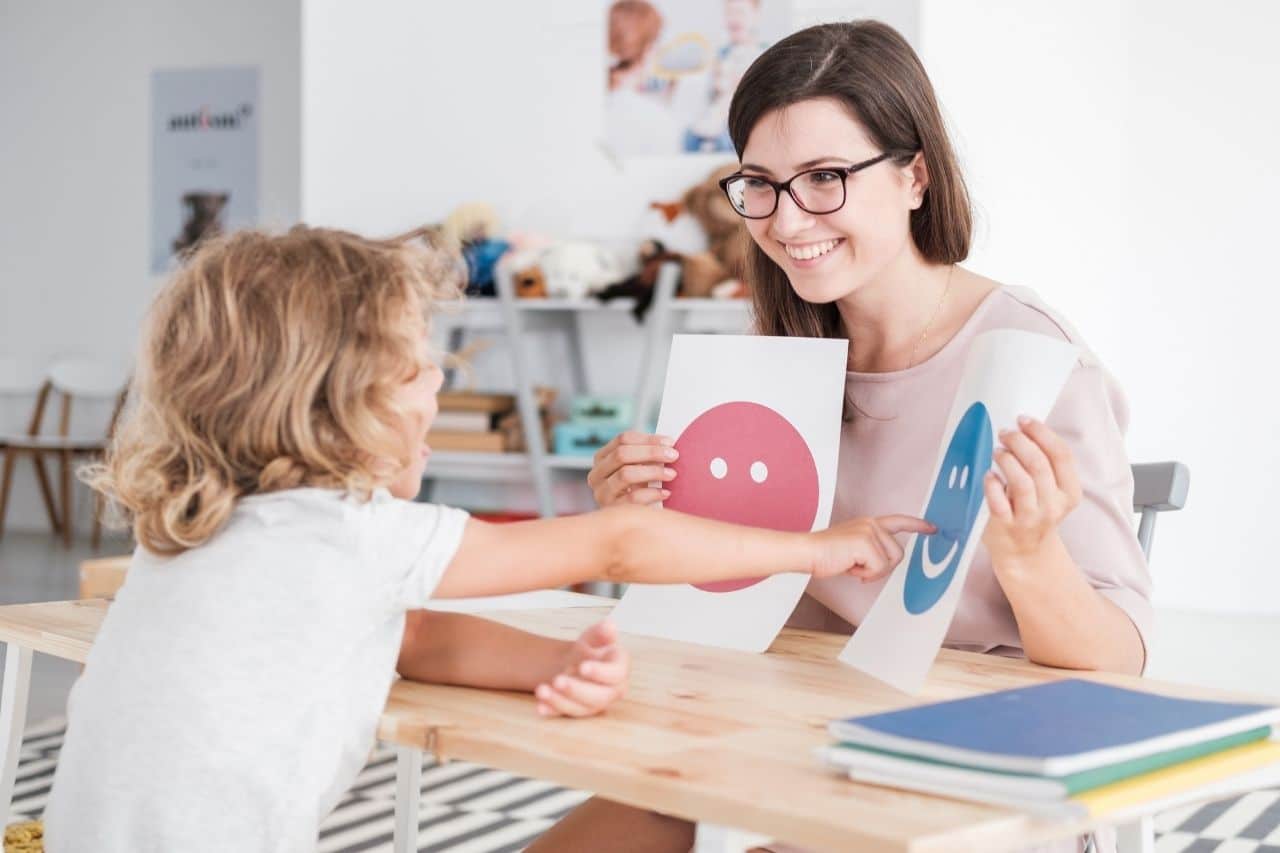
b) Promote kinesthetic learning
ADHD children can benefit from learning techniques that involve physical movement. Encourage them to use gestures or movements to represent concepts or ideas. For example, when learning vocabulary words, associate a specific movement with each word to reinforce memory. Kinesthetic learning engages the body in the learning process, which promotes concentration and retention of information.
c) Incorporate interactive learning games
Interactive learning games are a great way to engage ADHD children in learning while making the experience fun and engaging. Use educational apps or online games that have age-appropriate activities and learning areas. Interactive learning games provide an engaging, hands-on experience that stimulates interest and promotes learning.
d) Varying study methods
ADHD children can quickly tire of the same study methods. Try alternating learning approaches using videos, audio recordings, online learning games, etc. This will keep the child interested and motivated, stimulating different learning styles. By tailoring study methods to their preferences and needs, you promote better retention of information.
3. Collaborate with teachers
A strong partnership with teachers is essential to support the academic success of ADHD children. Here are some effective collaboration strategies:
a) Plan regular meetings with teachers
Have regular meetings with teachers to discuss your child’s progress, strategies that are working, and adaptations needed in the classroom. Share relevant information about your child’s ADHD for a better understanding of their specific needs.
b) Requesting classroom accommodations
Work with teachers to implement classroom accommodations that meet your child’s specific needs. This may include curriculum modifications, extra time for homework, use of visual aids, or other support strategies. By working closely with teachers, you ensure that the school environment is tailored to support your child’s success.
c) Encourage regular communication
Maintain regular communication with teachers to stay informed about your child’s progress and challenges in school. Be open to their suggestions and ask for updates on strategies implemented in the classroom. Open and regular communication promotes mutual understanding and allows for adjustments to support your child’s academic success.
By following these practical tips, you can play an active role in your child’s academic success with ADHD. Remember that each child is unique, so tailor strategies to their specific needs. With the right support and approaches, your child can overcome the challenges of ADHD and reach their full academic potential.
In summary, to support academic success for children with ADHD, it is important to establish a structured study routine, use multi-sensory learning techniques, and work closely with teachers. By combining these approaches, you can help your child develop effective study skills, maximize focus, and create a supportive learning environment.
Supporting ADHD children with the COCO THINK and COCO MOVE application
COCO THINKS and COCO MOVES is a program of educational and physical games for elementary school, in order to implement universal learning.
Children with ADHD have difficulty staying focused. It is therefore important to use games that work on theactivation or inhibition of movement, as well as games that require a specific response time.
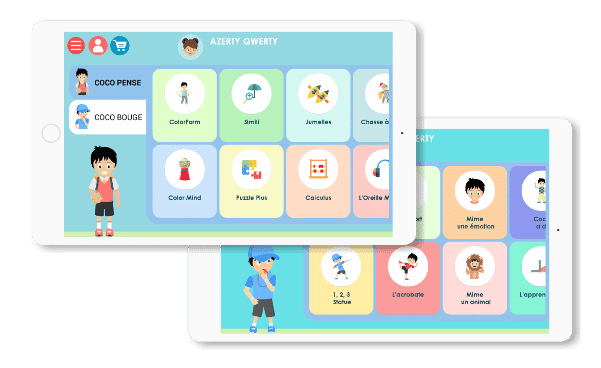
Adaptations of COCO THINKS and COCO MOVES for ADHD children
- Adapted physical exercises
- A personalized interface (possibility to hide games)
- Activities to teach body movement in space
- Activities for relaxation
- Activities that can be done sitting down
The mole invasion
In this game the child will see 3 different moles, and therefore 3 different stimuli. A normal mole he has to tap once, a mole with a helmet to tap twice and a mole with the glasses not to touch.
In this game we stimulate the activation and inhibition of the movement according to the stimulus. The child can learn to adapt to his environment, to take external information to choose which movement to make.
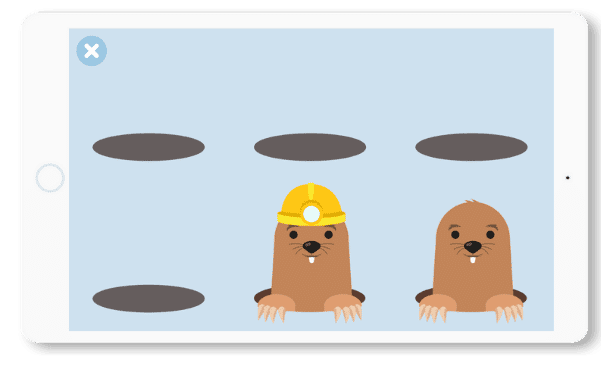
Balloon drill
In this game the child has to shoot arrows and reach the balloons according to the instructions.
In this game, there is no question of speed, but the child must watch the movement of the balloons and wait for the right moment to shoot. He must therefore stop his movement and wait for the best moment to shoot. The child must blow up only the balloons of one color, so it is very important to read the instructions carefully before starting to play.
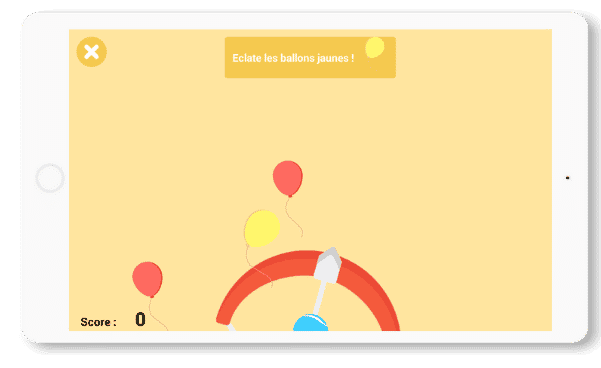
Snowball effect
In this game the child must press a single arrow to launch a snowball that must reach all the arrows on the screen. The child cannot quickly press the first arrow he sees, but must think carefully before acting. This game stimulates cause and effect, i.e. thinking about the consequences of an action.
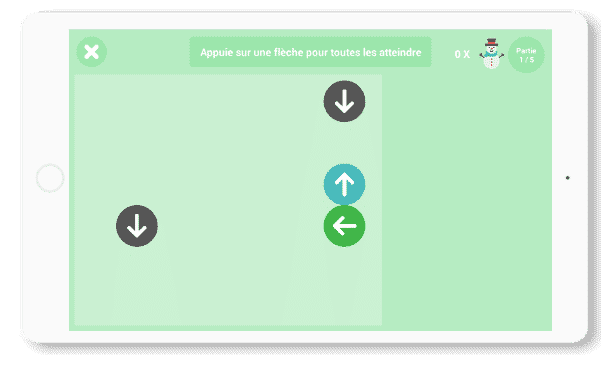
A follow-up of the evolution over time
In the application COCO THINKS and COCO MOVES there is a general score indicative of the performance, to know the level of competence. In addition, there are details on performance (time used to complete the activity, correct answers, movements needed and movements performed).
Children can see their strengths and areas for improvement:
if they need to improve their response time, strategy or skill, for example.
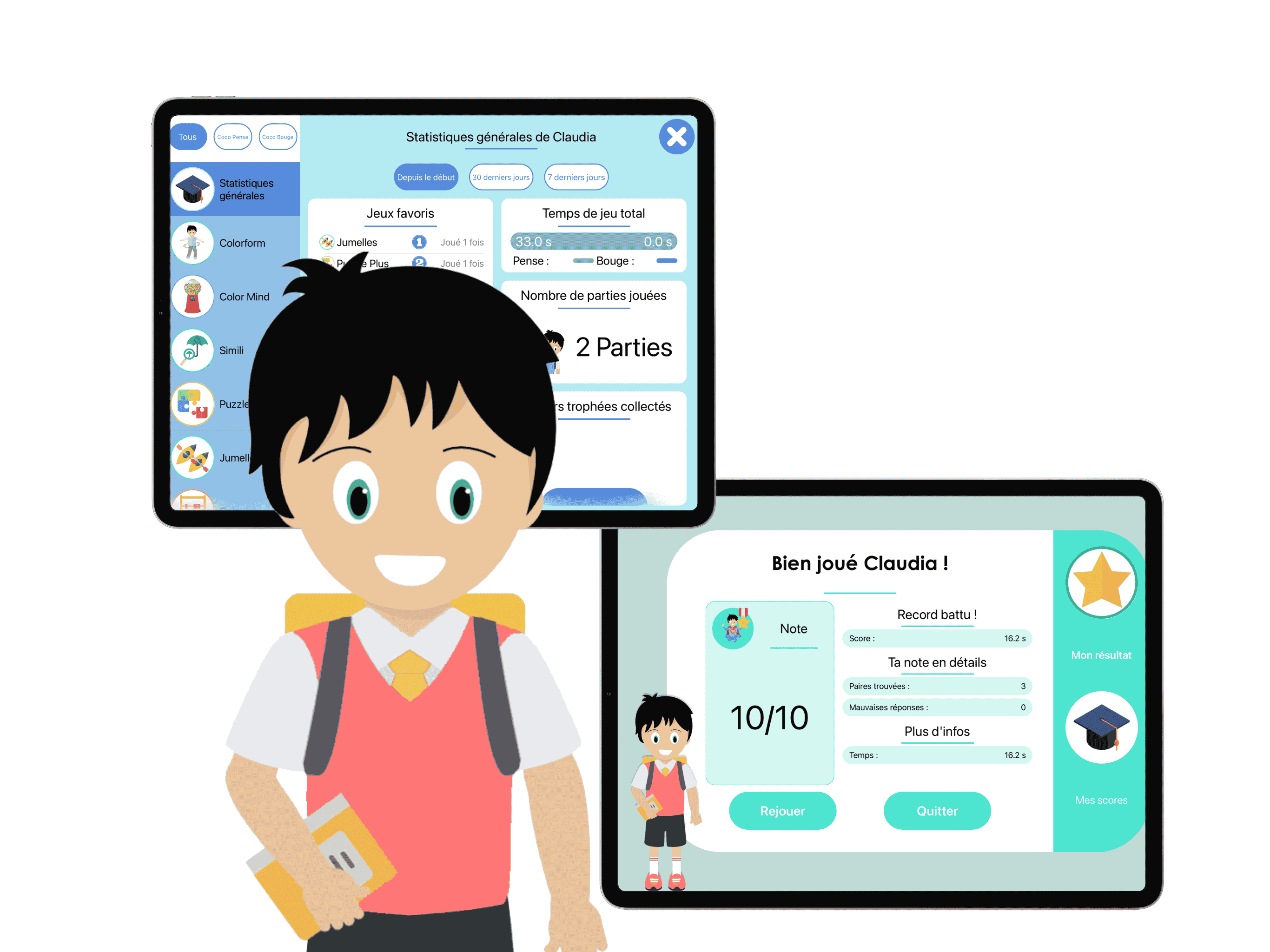
Other articles that might interest you:
Supporting children with autism
Dynseo proposesSUPPORTING CHILDREN WITH AUTISM with COCO THINKS AND COCO MOVESDynseo and its team are very much...
Supporting DYS children with COCO THINKS and COCO MOVES
Dynseo proposesDYS disorders with COCO THINKS and COCO MOVESOur educational and pedagogical games program COCO THINKS...
Language development
Children communicate from birth with movements, crying, looking at each other or with smiles. After only a few months,...
Supporting children with Down Syndrome with Coco
Dynseo proposesDOWN SYNDROME with COCODown syndrome is a non-hereditary chromosomal abnormality that leads to the...
Supporting people after a stroke
Dynseo proposesStroke with CLINT, your brain training coachThe Dynseo team is very involved in helping people who have...
Supporting someone with Alzheimer’s
In this guide, we will detail how SCARLETT can be used for supporting someone with Alzheimer's. SCARLETT is a...
10 myths about the human brain you didn’t know
The brain is an incredible muscle, however there are many things we do not know, and what we do know is not always...
Using Digital Tools to Support Students with Special Educational Needs
Special Educational Needs (SEN) encompass a wide range of learning difficulties and disabilities that can hinder a...
Down Syndrome and Communication: Facilitating Interaction with Visual and Interactive Supports
When we think about Down syndrome, we often recognize it as a genetic condition that affects physical and cognitive...
How to Track Progress in People with Down Syndrome Using Digital Tools
Down syndrome, a genetic condition caused by the presence of an extra chromosome 21, affects approximately 1 in every...


